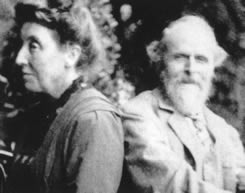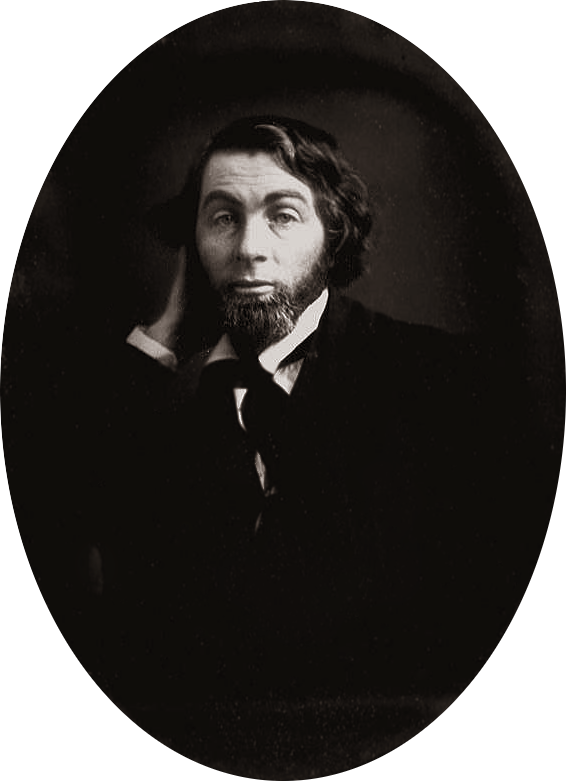|
The Deserted House
"The Deserted House" is a poem written by Alfred, Lord Tennyson in 1830, as part of his collection ''Poems, Chiefly Lyrical''. The poem is characterised by its reliance on short lines which alternate in rhyme and meter to prevent a felicitous feel. In the poem, Tennyson uses the image of a dark house as a metaphor for a dead body Background "The Deserted House" was printed along with other poems of Tennyson's juvenilia in his collection, ''Poems, Chiefly Lyrical'' of 1830. The poem was printed alongside works that included "The Dying Swan", "The Mystic", "Ode to Memory", "The Sleeping Beauty", and the later suppressed poem, "The Grasshopper". Poem The poem exhibits lyrical economy with its reliance on short lines. The lines themselves alternate in rhyme and meter in a manner that keeps the poem from having a felicitous feel to it. The first four stanzas of the poem describe the emptiness of a house, while the fifth, final stanza reveals that the empty house is a metaphor for ... [...More Info...] [...Related Items...] OR: [Wikipedia] [Google] [Baidu] |
Alfred, Lord Tennyson
Alfred Tennyson, 1st Baron Tennyson (6 August 1809 – 6 October 1892) was an English poet. He was the Poet Laureate during much of Queen Victoria's reign. In 1829, Tennyson was awarded the Chancellor's Gold Medal at Cambridge for one of his first pieces, "Timbuktu". He published his first solo collection of poems, ''Poems, Chiefly Lyrical'', in 1830. "Claribel" and "Mariana", which remain some of Tennyson's most celebrated poems, were included in this volume. Although described by some critics as overly sentimental, his verse soon proved popular and brought Tennyson to the attention of well-known writers of the day, including Samuel Taylor Coleridge. Tennyson's early poetry, with its medievalism and powerful visual imagery, was a major influence on the Pre-Raphaelite Brotherhood. Tennyson also excelled at short lyrics, such as "Break, Break, Break", "The Charge of the Light Brigade", "Tears, Idle Tears", and "Crossing the Bar". Much of his verse was based on classical mytho ... [...More Info...] [...Related Items...] OR: [Wikipedia] [Google] [Baidu] |
Poems, Chiefly Lyrical
''Poems, Chiefly Lyrical'' is a poetry collection by Alfred Tennyson, published in June 1830. Contents The poems are fifty-six in number: Of these the poems in ''italics'' appeared in the edition of 1842, and were not much altered. Those with an asterisk were, in addition to the italicised poems, afterwards included among the ''Juvenilia'' in the collected works (1871–1872), though excluded from all preceding editions of the poems. Those with both a dagger and an asterisk were restored in editions previous to the first collected editions of the works. History ''Poems, Chiefly Lyrical'', was published in 1830 by Effingham Wilson, also the publisher of Robert Browning's ''Paracelsus''. The volume had the following title-page: ''Poems, Chiefly Lyrical, by Alfred Tennyson''. London: Effingham Wilson, Royal Exchange, 1830.Collins 1900, p. vii. Favourable reviews appeared by Sir John Bowring in the ''Westminster'', by Leigh Hunt in the ''Tatler'', and by Arthur Hallam in the '' ... [...More Info...] [...Related Items...] OR: [Wikipedia] [Google] [Baidu] |
The Lady Of Shalott
"The Lady of Shalott" is a lyrical ballad by the 19th-century English poet Alfred Tennyson and one of his best-known works. Inspired by the 13th-century Italian short prose text '' Donna di Scalotta'', the poem tells the tragic story of Elaine of Astolat, a young noblewoman stranded in a tower up the river from Camelot. Tennyson wrote two versions of the poem, one published in 1833, of 20 stanzas, the other in 1842, of 19 stanzas, and returned to the story in "Lancelot and Elaine". The vivid medieval romanticism and enigmatic symbolism of "The Lady of Shalott" inspired many painters, especially the Pre-Raphaelites and their followers, as well as other authors and artists. Background Like Tennyson's other early works, such as "Sir Galahad", the poem recasts Arthurian subject matter loosely based on medieval sources. It is inspired by the legend of Elaine of Astolat, as recounted in a 13th-century Italian ''novellina'' titled '' La Damigella di Scalot'', or ''Donna di Scalot ... [...More Info...] [...Related Items...] OR: [Wikipedia] [Google] [Baidu] |
Evelyn De Morgan
Evelyn De Morgan (30 August 1855 – 2 May 1919), née Pickering, was an English painter associated early in her career with the later phase of the Pre-Raphaelite Movement, and working in a range of styles including Aestheticism and Symbolism. Her paintings are figural, foregrounding the female body through the use of spiritual, mythological, and allegorical themes. They rely on a range of metaphors (such as light and darkness, transformation, and bondage) to express what several scholars have identified as spiritualist and feminist content. De Morgan boycotted the Royal Academy and signed the Declaration in Favour of Women's Suffrage in 1889. Her later works also deal with the themes of war from a pacifist perspective, engaging with conflicts like the Second Boer War and World War I. Early life She was born Mary Evelyn Pickering at 6 Grosvenor Street, to Percival Pickering QC, the Recorder of Pontefract, and Anna Maria Wilhelmina Spencer Stanhope, the sister of the art ... [...More Info...] [...Related Items...] OR: [Wikipedia] [Google] [Baidu] |
Blackwood's Edinburgh Magazine
''Blackwood's Magazine'' was a British magazine and miscellany printed between 1817 and 1980. It was founded by the publisher William Blackwood and was originally called the ''Edinburgh Monthly Magazine''. The first number appeared in April 1817 under the editorship of Thomas Pringle and James Cleghorn. The journal was unsuccessful and Blackwood fired Pringle and Cleghorn and relaunched the journal as ''Blackwood's Edinburgh Magazine'' under his own editorship. The journal eventually adopted the shorter name and from the relaunch often referred to itself as ''Maga''. The title page bore the image of George Buchanan, a 16th-century Scottish historian, religious and political thinker. Description ''Blackwood's'' was conceived as a rival to the Whig-supporting ''Edinburgh Review.'' Compared to the rather staid tone of ''The Quarterly Review'', the other main Tory work, ''Maga'' was ferocious and combative. This is due primarily to the work of its principal writer John Wilson, who w ... [...More Info...] [...Related Items...] OR: [Wikipedia] [Google] [Baidu] |
Walt Whitman
Walter Whitman (; May 31, 1819 – March 26, 1892) was an American poet, essayist and journalist. A humanist, he was a part of the transition between transcendentalism and realism, incorporating both views in his works. Whitman is among the most influential poets in the American canon, often called the father of free verse. His work was controversial in his time, particularly his 1855 poetry collection ''Leaves of Grass'', which was described as obscene for its overt sensuality. Born in Huntington on Long Island, Whitman resided in Brooklyn as a child and through much of his career. At the age of 11, he left formal schooling to go to work. Later, Whitman worked as a journalist, a teacher, and a government clerk. Whitman's major poetry collection, ''Leaves of Grass'', was first published in 1855 with his own money and became well known. The work was an attempt at reaching out to the common person with an American epic. He continued expanding and revising it until his de ... [...More Info...] [...Related Items...] OR: [Wikipedia] [Google] [Baidu] |
1830 Poems
Year 183 ( CLXXXIII) was a common year starting on Tuesday (link will display the full calendar) of the Julian calendar. At the time, it was known as the Year of the Consulship of Aurelius and Victorinus (or, less frequently, year 936 ''Ab urbe condita''). The denomination 183 for this year has been used since the early medieval period, when the Anno Domini calendar era became the prevalent method in Europe for naming years. Events By place Roman Empire * An assassination attempt on Emperor Commodus by members of the Senate fails. Births * January 26 – Lady Zhen, wife of the Cao Wei state Emperor Cao Pi (d. 221) * Hu Zong, Chinese general, official and poet of the Eastern Wu state (d. 242) * Liu Zan (Zhengming), Chinese general of the Eastern Wu state (d. 255) * Lu Xun, Chinese general and politician of the Eastern Wu state (d. 245 __NOTOC__ Year 245 ( CCXLV) was a common year starting on Wednesday (link will display the full calendar) of the Julian calenda ... [...More Info...] [...Related Items...] OR: [Wikipedia] [Google] [Baidu] |



